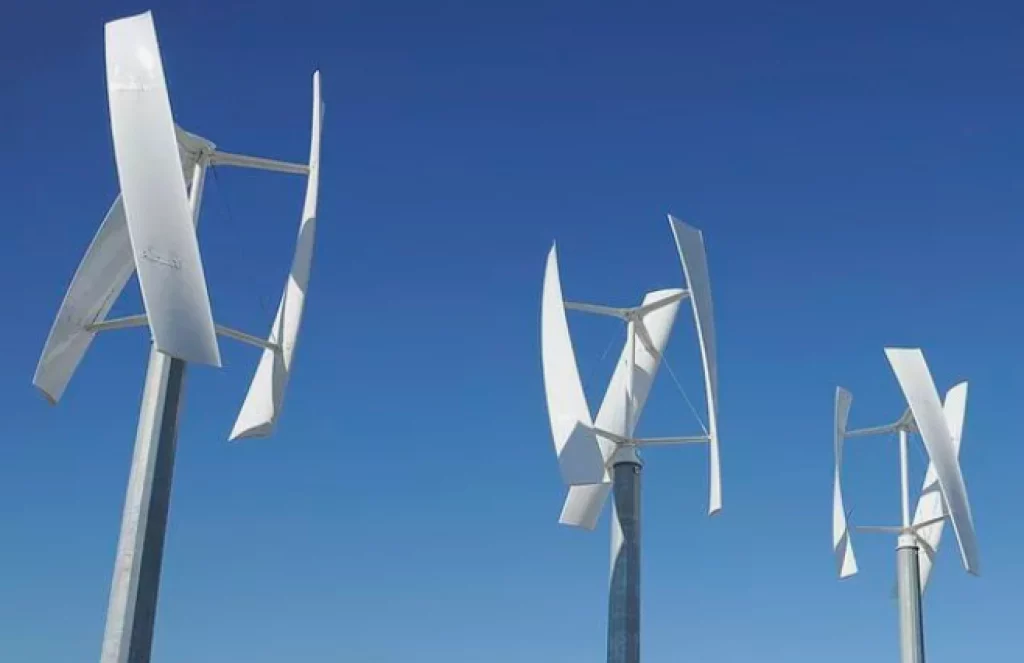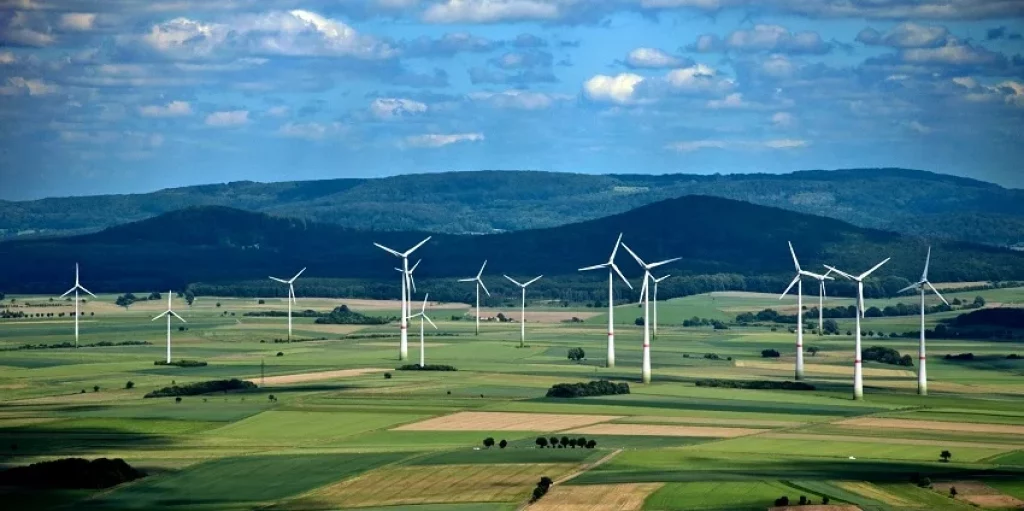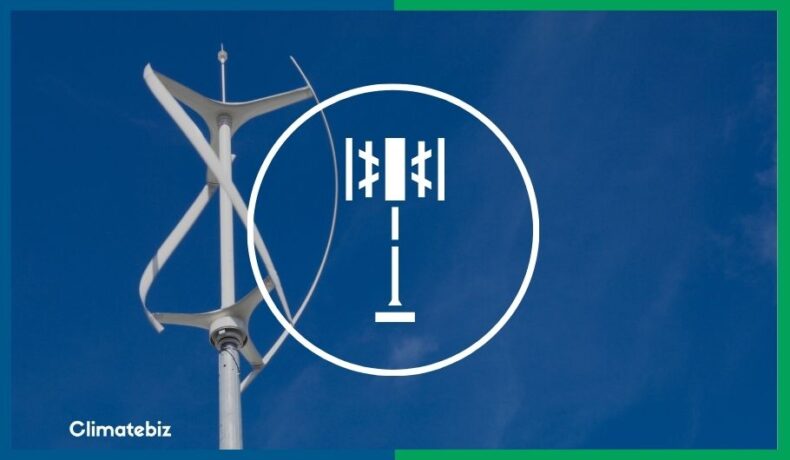Chances are you’ve heard of both vertical and horizontal wind turbines. But which wind turbine is more efficient, and how do they compare? This article will settle the vertical axis vs. horizontal axis debate.
Before we dive in, let’s look at how wind turbines became what we know them as today.
The first records of humankind harnessing wind date back to 5000 BC. Back then, ancient Egyptians would harness the wind to power their sailboats.
Then came windmills. These inventions allowed farmers to mill wheat and pump water. But since the industrial age, we haven’t had much use for old windmills. So instead, we now use the same concept to generate electricity for our homes.
67% of America’s electricity comes from fossil fuels, while only 4.7% comes from wind. Yet, wind power can provide us with more energy, both residentially and commercially. We can even install wind turbines in our urban spaces and power our homes directly.
That brings about the question, which wind turbine is better, vertical axis or horizontal axis wind turbines?
Table of Contents
Vertical Axis Vs. Horizontal Axis Wind Turbines

Source: commons.wikimedia.org
If you’re new to understanding wind turbines, there might be some words you don’t recognize. So, to speed things up, let’s look at some of the terms we’ll be using:
- HAWTs: horizontal axis wind turbines.
- VAWTs: verticle axis wind turbines.
- Computational fluid dynamics: software that helps calculate wind movement, especially around buildings. It’s also known as CFD.
- Yaw system: allows the turbine rotor to face the wind to enable maximum efficiency.
- Betz limit: the maximum and ideal efficiency that a wind turbine should reach. Betz law states that no wind turbine will ever harness 100% of the kinetic energy from wind. Instead, turbines harness around 59.3% of the available power. This is known as the Betz coefficient (0.593).
- Cut-in speed: the lowest wind speed that a turbine needs to operate and produce electricity.
These definitions will pop up throughout the article, so feel free to refer back to this section.
Now, let’s look at the direct comparisons between vertical axis vs. horizontal axis turbines.
We’ll use the following factors to compare the two turbines:
- Wind direction
- Wind conditions
- Generator location
- Noise production
- Building & setup
- Betz limit efficiency
- Cut-in speed
Comparison Table
| Factors | HAWTs | VAWTs |
|---|---|---|
| Wind direction | The efficiency of horizontal axis turbines is dependent on the direction of the wind. HAWTs require a one-directional breeze to be able to produce the most electricity. It’s difficult for the rotor to turn and face the wind, meaning that multi-directional winds make the turbine less efficient. | Verticle axis turbines can produce electricity despite the direction the wind is blowing. Their blades harness the kinetic energy from Omni-directional winds, making them productive in most wind conditions. |
| Wind conditions | HAWTs perform better in the smooth, low-turbulent wind. They are most efficient when the blades are perpendicular to the wind. That is why most HAWT wind farms are found on open planes. However, this makes them less efficient in urban areas. | VAWTs can operate in all wind conditions, including turbulent winds. This makes them better for urban areas as buildings create wind turbulence. However, turbulence creates a backtrack (when the blades spin in reverse), decreasing efficiency. |
| Generator location | The generator of a HAWT is located right behind the rotor, on top of the tower. This requires that the turbines have balancing systems and a structurally stable base. In addition, the electricity is then transferred from the generator and into the grid. The transfer from the top of the tower to the ground can result in a loss of electricity. | The EPA states that 5% of electricity is lost during transfer. And while the transfer distance in turbines isn’t far, it gives VAWTs an edge. The generator for these turbines is located at the turbine’s base and directly connected to the electrical grid. |
| Noise production | Our Small Wind Turbine For Home Use article stated that HAWTs create about 55db of sound from 10 feet away. That makes HAWTs as loud as a household refrigerator. This decibel level isn’t considered noise but can be heard if you concentrate. | In comparison, this study states that VAWTs are 38db loud. That makes VAWTs 60% quieter and at the same decibel level as a whispered conversation. |
| Building & setup | The taller the tower of a HAWT is, the more efficient it becomes. In some cases, the output increases by 34% for every 32 feet up. However, this makes HAWTs challenging to install, needing a crane and guy-wire for support. HAWTs can be installed on top of building roofs in urban areas but won’t be as efficient. | VAWTs don’t need to be situated on tall towers and can be installed on the ground. This makes installation and maintenance much more accessible. In addition, they’re ideally suited for urban areas with no need for high wind speeds. |
| Betz limit efficiency | HAWTs reach around 75% – 80% of the Betz limit. So in total, HAWTs only produce between 35% – 45% of their full potential. However, HAWTs still generate more electricity than their VAWT counterpart regardless of this. | Verticle axis turbines are consistent and efficient. There are still many studies going on regarding its Betz limit. However, it’s said that VAWTs produce just under the Betz limit. Unfortunately, the turbine is mainly exposed to slower wind speeds. Because of this, it doesn’t create as much electricity as a HAWT does. |
| Cut-in speed | HAWTs require between 6 and 9 mph wind speeds to generate electricity. Luckily, this falls into the range of average wind speeds across America. Another benefit of HAWTs is that they do not need additional help to start, unlike VAWTs. | As we just mentioned, VAWTs need extra help to start turning. This is often provided through a small rotor. However, VAWTs can run at much lower wind speeds than HAWTs once started. |
Vertical Or Horizontal Wind Turbines — Which Is Better For Commercial Use?

Source: winwithwind
Surprisingly, a vertical wind turbine farm produces more electricity than a horizontal wind turbine farm. This is surprising because, on its own, a HAWT is more efficient than a VAWT. However, when a commercial wind farm places VAWTs together, they boost each other’s efficiency.
Grid Formation
By placing verticle axis turbines in a grid formation, the turbulence from one turbine affects its neighboring turbines. This causes each VAWT to boost the efficiency of the turbines alongside it. In fact, it’s been proven that it can increase performance by 15%.
The research comes from a team at Oxford Brookes University and can be found in this academic paper.
What A Hawt Produces
Additionally, research from Standford states that a HAWT farm produces 2 – 3 watts per 10 square feet. However, because VAWTs can be placed closer together, a VAWT farm produces 30 watts per 10 square feet.
Despite this fact, most wind farms around the world consist of HAWTs. At the moment, horizontal wind turbines seem to be more trusted as there is a lot more research into these turbines.
For those of you who are curious, one HAWT can produce 843,000 kWh in one month. That equates to supplying power to 950 homes for a month.
Vertical Or Horizontal Wind Turbines — Which is Better for Home Use?
Vertical axis vs. horizontal axis for home use is just as complicated. Again, you’ve got to consider the cost, maintenance, efficiency, and noise when choosing one for home use.
Efficiency
HAWTs can generate enough power to reduce your electricity bill by 50%. But this also requires optimal conditions. You need to have the right wind resources, open space for the tower, and an efficient turbine.
On the other hand, a VAWT will be able to generate electricity at almost any windspeed. However, it still wouldn’t be able to reduce your utility bill as much as a HAWT.
A case study at Clark University, Massachusetts, showed that the HAWT was more efficient. It generated more power, ranging from 0Wh to 258Wh daily, while the VAWT peaked at 146Wh. However, the VAWT was more consistent as it never dropped below 0.26Wh.
Urban Setting
Another factor to consider is that our homes are in urban settings. Not every home has a large enough outside area to erect a wind turbine tower. However, there is always the option to install a HAWT on your home’s roof. This will give it the height it needs, but buildings around it will still affect it.
Wind Shadows
For example, wind shadows are a common issue for wind turbines in urban areas. These ‘shadows’ are spots where the wind doesn’t reach because of buildings or objects in the way. If your wind turbine falls into a wind shadow, it won’t be nearly as efficient as it should be.
Wind Turbulence
The last issue for HAWTs in an urban area is wind turbulence. Because the wind is deflecting off surrounding buildings and trees, it’s never in a constant direction. For a HAWT to reach peak productivity, the blades must be parallel to the wind direction.
The Better Fit
In conclusion, VAWTs are a better fit for particularly dense urban areas. They can generate electricity regardless of wind turbulence and without height. In addition, they can create energy at low cut-in speeds. However, you’re probably going to need more than one to meet your energy demand.
Vertical Axis Vs. Horizontal Axis Wind Turbines — Which Is More Efficient?

Source: azocleantech
We’ve looked at both the advantages and disadvantages of wind turbines. Each turbine has a specific condition in which it thrives. Choosing a suitable wind turbine would be dependent on your site and wind resource.
But which is more efficient regardless of external factors like urban areas and turbine arrays?
Based on this study’s information, we can say HAWTs are more efficient. According to the above case study, they can produce more electricity than a VAWT in the same wind conditions. For example, the HAWTs generated 55% more electricity than the VAWTs. This was because the verticle axis wind turbines experienced backtracking.
HAWTs’ additional height allows them to harness the wind with higher kinetic energy. This, combined with their large sweep areas, can generate more electricity per square foot.
Final Thoughts
We’ve sifted through a lot of information to compare vertical axis vs. horizontal axis wind turbines
While it’s clear that the horizontal axis wind turbine is more efficient, it doesn’t make it the best. The best turbine for you would be the one that suits your energy needs and available wind resource.
If you’re planning on using wind power for your home, we hope we’ve cleared some doubt. Using our comparison table would help you choose which turbine best suits your home.
A conclusion that we’ve seen multiple times is that VAWTs have so much more potential. So we’re excited to see what new research and technical advances arise in the future.

